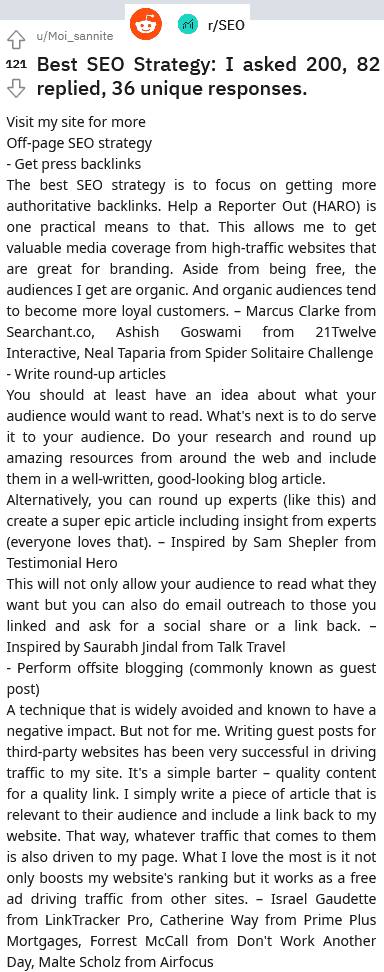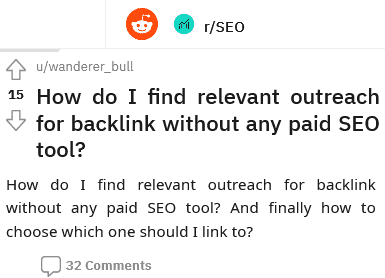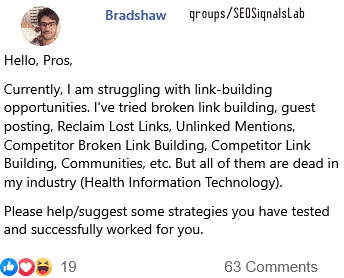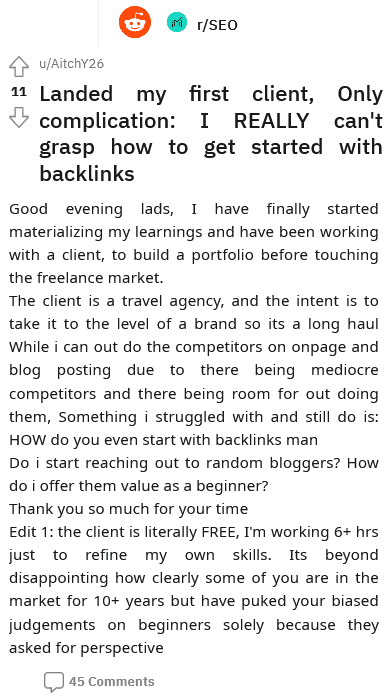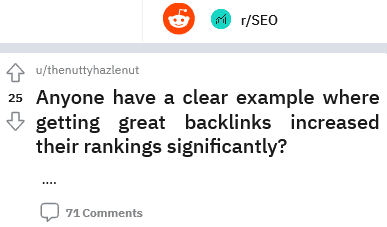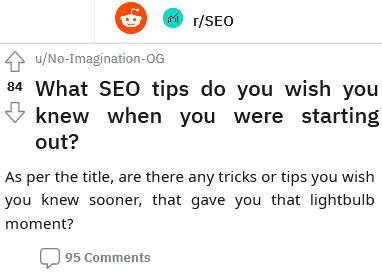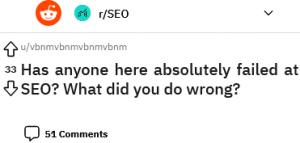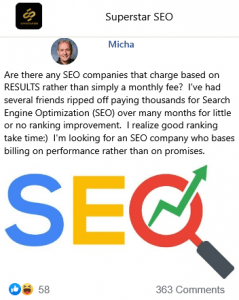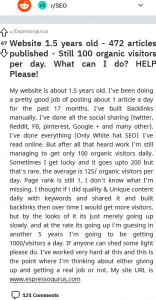Best SEO Strategy: I asked 200, 82 replied, 36 unique responses.
Visit my site for more
Off-page SEO strategy
– Get press backlinks
The best SEO strategy is to focus on getting more authoritative backlinks. Help a Reporter Out (HARO) is one practical means to that. This allows me to get valuable media coverage from high-traffic websites that are great for branding. Aside from being free, the audiences I get are organic. And organic audiences tend to become more loyal customers. \- Marcus Clarke from Searchant.co, Ashish Goswami from 21Twelve Interactive, Neal Taparia from Spider Solitaire Challenge
– Write round-up articles
You should at least have an idea about what your audience would want to read. What's next is to do serve it to your audience. Do your research and round up amazing resources from around the web and include them in a well-written, good-looking blog article.
Alternatively, you can round up experts (like this) and create a super epic article including insight from experts (everyone loves that). \- Inspired by Sam Shepler from Testimonial Hero
This will not only allow your audience to read what they want but you can also do email outreach to those you linked and ask for a social share or a link back. \- Inspired by Saurabh Jindal from Talk Travel
– Perform offsite blogging (commonly known as guest post)
A technique that is widely avoided and known to have a negative impact. But not for me. Writing guest posts for third-party websites has been very successful in driving traffic to my site. It's a simple barter \- quality content for a quality link. I simply write a piece of article that is relevant to their audience and include a link back to my website. That way, whatever traffic that comes to them is also driven to my page. What I love the most is it not only boosts my website's ranking but it works as a free ad driving traffic from other sites. \- Israel Gaudette from LinkTracker Pro, Catherine Way from Prime Plus Mortgages, Forrest McCall from Don't Work Another Day, Malte Scholz from Airfocus
📰👈
– Reach out to relevant bloggers
To build links, you have to do some serious outreach work. Find blogs that have written articles in a similar area, and email them to suggest that they link to your incredibly relevant article. For businesses in competitive industries, link building is a must if you want to outrank your competitors. \- Andy Cabasso at Postaga
– Create quality content and outreach (aka skyscraping)
Instead of contacting every site on the web to ask for a guest post, we identify the big players in the industry that are actual brands with blogs. Then, we spend weeks crafting a piece of epic content with data, statistics, unique graphics, etc. When we pitch a guest post to them with the content we've created, they almost always say yes. This secures us such great backlinks that we, thankfully, don't have to do a lot of link building. \- Alex Williams at The Website Flip, Jacob from FitzDesignz, Brian Robben from Robben Media
– Use Google My Business
Invest in GoogleMyBusiness optimization. You need to contribute often via posts, offers, and videos. This will push your rankings in the map pack. \- me
– Broken link building
My best SEO strategy is finding broken links by using Ahrefs . I look for the links that I could replace in the needed category. After I have found some, I will create a new article that could replace the old broken link, unless I already don't have the suitable one. The next step is to inform the publisher about their broken link with my new valuable link. It is not only beneficial for me but also for the publisher because broken links on the page are a bad experience for users and can also negatively affect SEO. \- Jete Nelke from Food Docs
– Find hidden gems by Ahrefs Content Explorer
– Appear on podcasts
Step 1. First, we search for podcasts that we want to appear on, and that is relevant. We brainstorm 'keywords' to try to narrow down which podcast our target audience would be listening to. These keywords can be people, or broader topics such as 'Millennials', 'Finances', etc. And once we have our list, we type into Google "TOPIC" inurl: podcast'. This gives us a base list to work off.
Step 2. We need to be able to get in contact with these people who are associated with the Podcast \- ideally the email address of the host. There are tools available online such as Hunter.io, Voila Norbert, RocketReach who will help source these email addresses for you.
Step 3. Send that pitch! One of the things that we like to do when sending out outreach emails is timing the end of these emails. We find that these emails have a better chance of being responded to when if we were to send them in the afternoon \- either just before or after lunch.
We avoid sending them in the morning as that tends to get lost in the avalanche of emails that comes through to a person's inbox overnight. Additionally, like with any other outreach emails we send, we only send 3 times to the same email address \- we mostly get responses in the 2nd or 3rd email we send out.
If we don't get any response, we move on to the next email for the same company/podcast that we found in step 2.
Step 4. When you've successfully managed to reach out to someone who is interested in what you have to say \- record that podcast!
Step 5. Share and promote the podcast with the world \- it'll be rude not to.
Step 6. If the podcast host hasn't linked to your website already, reach out to them with a follow-up email thanking them for letting you appear as a guest, and kindly ask for a backlink
\- David Toby at Pathfinder Alliance
Content SEO strategy
– Create E.A.T. content
E-A-T stands for expertise, authority, and trustworthiness. Google no higher rank just good, engaging content. Now, they are concerned that a piece of content that ranks is unreliable and can damage the potential searcher. This is especially relevant in the YMYL (your money or your life scene). You see sites in the health space, law space, or financial space having issues with Google algorithm updates because their information may be unverified. Google is requesting that sites present their expertise, authority, and trustworthiness. Google goes into great detail about how to measure if a site or page has the qualities needed to reap a good E-A-T rating. \- Andrei Vasilescu from DontPayFull, Cyrus Yung from Ascelade, Brack Nelson at Incrementors SEO Services, Greg Birch from StoreSpace
– Focus on long-tail keyword
This is common knowledge in Search Engine Optimization (SEO), but its success is easy and impactful that it deserves a mention. By the time you join the SEO game, your competitors would have already dominated the top money keywords. You are now presented with two choices: Go big, challenge them with a massive amount of investment, or go small, wait for your chance to overpower their site.
Although long-tail keywords have a much smaller audience, they are much more specific, less competitive, and will therefore appeal to a more attainable audience. To give you an example, if our firm only used short-tail keywords like "law firms", this would appeal to a large audience that could have varying needs and expectations and will also be competing with all the other content which uses them.
If we use long-tail keywords like "law firms Virginia", you can see how this would appeal to a more specific audience. Using keywords isn't all about the size of the audience, but rather the potential for a response that you might get from an audience. \- Peter Horne at McDonald Injury Law, Omer Reiner from Florida Cash Home Buyers
– Test your funnel
Your content is created with the purpose to drive traffic and eventually, sales. You can forsake the conversion rate game in pursuit of traffic but if you already have a strong presence, you will need to up your conversion rate game.
To make the most of your SEO strategy and increase conversion rates, it is essential to A/B test faster than all your competitors. Constantly be testing and improving every step of your sales funnel. For your website, constantly test new copy on your landing pages. The faster you can test, the faster you will find the best results, and the faster your business will grow. \- Ray Blakney at Live Lingua
– Conduct "search intent keyword research" and optimize for it
Let's say for example that you are a dentist, you might think that ranking for the keyword 'tooth pain' is a smart option, but if you actually conduct a search on Google for that term, you'll see that not one single dentist is ranking for that, as Google has determined that the search intent (what the majority of people actually want to see in the results) are home remedies for getting rid of tooth pain, or what are the causes of tooth pain, etc.
This means if a dentist did not conduct this research, but went ahead and spent their resources trying to rank for this, they are fighting a very difficult uphill battle. It doesn't take much time to do this research, and can honestly make or break the success of your SEO efforts. It's important to get it right from the start, otherwise, every other SEO strategy that you implement after that is potentially wasted effort. \- Ryan from LandofRugs, Daniel from The Snow Agency, Mark Armstrong from Mark Armstrong Illustration, Joel Shetler from WorkSuites, Nijat Huseynov at TonerBuzz, Charles McMillian from Stand With Main Street, Willie Greer from The Product Analyst, Ernests Embutnieks from World of Tablet, John Webster from Voyagers Travel, Jake Peterson from Atiba, Saad Qureshi from Ivacy
In other words, your content should be answering their search question in an engaging way. Your content should make them want to share and read it. Your content should impress. Your content should be written for humans \- Inspired by Edward Eugen from 10Beasts and Perryn Olson from Rex Engineering
– Work on topic clusters
Rather than focusing on keywords, we have decided to instead work with topic clusters, which allows us to more accurately target the needs of our potential clients and appear in organic searches. Yes, some people search keywords, but many still search in sentences and we will be there for those individuals. \- Andrew Taylor from Net Lawman
– End the search journey
Create truly comprehensive content that concludes the search journeys. What that means is that after landing on your web page from organic search, the visitors close the tab altogether, versus going back to search or running a new query. There's no way to define what "comprehensive content" means \- that depends on your specific industry and the search intent. But as long as your content fulfills the searchers' needs \- your SEO strategy is bound to succeed. \- Vlad Shvets from Paperform
– Improve your readability
Readability is everything. If people are getting to your page but not staying, your page likely needs some improvements. Rich media, writing around a 6th-grade reading level, providing a table of contents with anchor links are just some ways to improve scanning/readability (and subsequently, bounce rate). \- Lyamen Savy from 321 Ignition
– Create long-form content
The #1 SEO strategy is to create definitive long-form content. I'm not talking about an article that's 1,000 words or even 2,000. I'm talking 3000+ words. By creating an ultimate guide, we saw our rankings for the keyword we wanted skyrocket to an average SERP ranking of 1.3. This gargantuan article covers everything a potential buyer would need to know about buying the product. By doing this we created a resource for potential buyers that's also the perfect resource for external websites to build links to. This led to a tremendous increase in traffic, organic links, and most importantly sales. Content is king! Long live the king! \- Asher Weinstein from ProjectorScreen, Felix Bodensteiner from TableLabs
We frequently use original research and data in our content. The data is fact-based and usually displayed in visual charts that tell a story. This makes it easy to convey the findings and it is differentiated from normal text. Uniqueness is the key and it must add distinct value. \- Kevin Miller from GR0, Reuben Yonatan from GetVoIP
– Create content pillars
Along the lines of creating long-form content, this SEO specialist has even longer ambitions (pun intended).
My best SEO strategy that has driven significant traffic and clients over the years has been keeping my blog exclusive to pillar posts and interlinking them. I achieve this by comprehensively covering every topic that I discuss, generally 5,000 words or more per blog post where I link back to each one of my previous blog posts. Then, once the post is complete, I go back into my pre-existing blog posts and link to my new one with the anchor text that I want to rank for. \- Tanner from Source Approach, John from Roofing Webmasters
– Employ Natural Language Processing (NLP)
The best SEO strategy that we have employed is focusing on Natural Language Processing (NLP). This is writing in a simple, direct manner that Google always understands. This means answering questions by restating the question, cutting down on sentence length, and reducing "personality" in blog posts.
Taking away a lot of the personality from articles (particularly from the beginning of each section) is scary to a lot of clients, who really want to connect with their readers on a personal level. However, Google values NLP because it is simple to understand, it gets straight to the point without wasting the reader's time, and it answers questions instead of dancing around them. \- T. Josiah Haynes from Content Creators Agency, Jeremey Alderman from TechnologyAdvice
– Siloing content
We are doubling down on siloing as a way to rank for more difficult, larger keywords in the long term by organizing and internal linking content in a logical way. The way we have organized these silos is to consider where the reader first lands, where their second click would be, and then their third click. This helps to put content together into groups or silos so that Google understands the relationship between the content and helps our first click page to rank higher, overall, for the most difficult keywords we have ID'd as long-term targets. We use internal linking with focus keywords to help signal to Google the keywords to rank that page for. \- Kristine Thorndyke from Test Prep Nerds
– Steal your competitor's strategy
Nowadays, there are countless platforms you can use to see exactly what your competitors are doing to get traffic. SEMrush and Ahrefs are just two examples that are as powerful as they are affordable. Pick one and then get busy reviewing your competitors' websites for what keywords they're successfully targeting and, just as important, what pages they're using to target them. There's plenty of room for ingenuity and to improve on what the competition is doing, but if you start from scratch, you're going to waste a lot of time and money. SEO is a lot simpler when you let your competitors help. \- John Greving from IWD Agency
– Flip the intent hierarchy
The best SEO strategy I've ever used is to flip the intent hierarchy. Most businesses try to focus on top-of-funnel content. These keywords tend to drive lots of traffic, but also provide very little business value. Instead, you need to first exhaust your middle of funnel and bottom of funnel keywords. These tend to drive little traffic, but that traffic also tends to drive a lot more sales. \- Danavir Sarria
– Identify keyword gaps and utilize them
The fastest way to find out what "keyword gaps" your site has is to use a tool like SEMrush, Moz, or Alexa Internet to identify what keywords your site is ranking for. Compare this to the keywords that your top competitors and key industry sites are ranking for. With this, you'll find your keyword gaps, including whole clusters of keywords that have been blind spots for your company. Use this list to create valuable, SEO-friendly content to attract visits from your target personas. \- Tom Treanor from Treasure Data.
Technical SEO strategy
– Adopt mobile-first policy
Google was known to consider the desktop versions of the websites in the search rankings. However, in the first half of <year>, Google has announced its new policy to prioritize the mobile-first indexing for every website in the search results from April <year>.
This means that your website must be fully compatible with any mobile platform if you want it to be ranked on the first page. Your website must be fully surfaced in the most suitable manner on any mobile screen. You might use Google's mobile-friendly test tool to determine your website's mobile-friendliness and check how it's rendering on mobile devices. \- Andrei Vasilescu from DontPayFull, Mansi Fatnani from Elsner and Audrey Truitt from My VirtuDesk, April Maccario from AskApril.
– Optimize your crawl budget
Crawl budget means the number of web pages Googlebot crawls and indexes within a particular time frame. If your number of web pages exceeds your website's crawl budget, Google crawl might not be able to crawl and index your website's essential pages. If your important pages do not receive organic traffic, you will have no conversion and no business. So a crawling budget is very crucial. The best way to increase the crawling budget is by identifying non-relevant pages from your website, such as tag pages, categories pages, author pages, and block them from the robots.txt file. \- Simon Dwight at SDK Marketing.
– Perform internal linking
Linking to other pages or blog posts on your website helps search engines crawl your website. It helps your audience discover more of your content and to know you as a trustworthy and credible source of information. Internal links to other valuable content keep users on your site longer, reducing your bounce rate and increasing your conversion potential. Always think about whether these links are naturally related to your topic and whether they will offer significant value to your readers. \- Simon Dwight from SDK Marketing, Aastha Shah from Meet Anshi, Roberto Torres from Turrem.
– Write shorter and compelling meta descriptions
Google has now come back to its previous limit of 155-160 characters for meta-description. Therefore, bidding farewell to longer meta descriptions is a must. When your click-through rate deteriorates, you're just directly telling Google that your site isn't trustworthy and will definitely pull your site down in the search engine result pages. To avoid this, you need to write a short but unique description for every page you have.
Make sure to place the most intriguing and compelling descriptions in the first 60 characters. With it, your users will clearly have a glimpse of what's on your site, and they're definitely going to click on it directly. The more clicks the better your click-through rate is. The more useful and trustworthy it'll look to Google, the better Search Engine Result Page (SERP) ranking you'll have. \- Jeff Walker at Best Virtual Private Network (VPN) Canada, William Cannon from Signaturely, James Idayi from Cloudzat
– Write captivating SEO titles
Title tags are what will appear in search results and they are what give users an insight into the content and why it is relevant. With a title tag that includes target keywords and matches the user's search intent, it is more likely it will be higher in rank. \- Mehvish from Zen Media, Tareihk Geter from OSI Affliate Software, Sonya Schwartz from Her Norm
Type your keyword into Google and look at the title tags in the top 5 results. Those title tags are there because they're getting results (i..e., high Click Through Rate (CTR)). Don't copy another web page's title tag but instead see if you can come up with an even better variation. \- Rob Powell from Rob Powell Biz Blog
– Improve your page speed
Making sure that your website loads and performs well not only improves your rank on the search engines but will also guarantee that the visitors of your website are given the best experience possible. \- Simon Elkjær from avXperten, Justin from JS Interactive, Michelle Devani from lovedevani, Kinjal Vyas from Global Vincitore, Lucas Travis from Inboard Skate, Mark from Shotkit, Monique Gesmundo from Growth Rocket, Tayyab from WPBrigade, JJ Lee from Digital Funnel
This is in line with Google's newest Core Web Vitals update. The update where they placed an enormous emphasis on on-site experience and how it can dramatically alter your search engine results. You can do this by removing unnecessary Cascading Style Sheets (CSS), unnecessary plugins, unnecessary code, and over-complicated site animations. Your site should pass the Core Web Vitals test accessible from Google Search Console (they also provide insights into what problems your site has).
– Improve your UX (user experience)
Incorporating UX is an integral part of SEO best practice. Content needs to be easily digestible and written in a way that provides an optimal user experience. This means that writers should avoid long blocks of text, filled with jargon. Headers should help the user understand what different segments of the article are about and provide structured organization. Infographics and images will also play a key role as far as communicating information with the user in an engaging way. \- Kimberly Smith from Clarify Capital, Samantha Moss from Romantific, Chris Nutbeen from Nuttifox
– Optimize for voice search
Voice user interface allows users to interact with websites through voice commands so it adds usability and functionality to your site making it accessible to all users including those with limitations and disabilities. One key trend to address and tackle to grow your audience today is that smart speakers and voice search are growing in importance so being able to optimize for voice search will be key to maximize the marketing and advertising opportunities on Siri, Alexa, Google Home, etc. Are you prepared when customers ask for help like "Alexa ask Nestle for an oatmeal cookie recipe" or "What is the best Mexican restaurant in London?" If not, you are missing a big opportunity! There are always new shiny objects in marketing to distract you, social media and technology are 24/7, but Search Engine Optimization (SEO) is here to stay whether it is via Google or voice. \- Paige Arnof-Fenn from Mavens And Moguls
– Shorten your URLs
The best SEO strategy that has worked wonders for our site is short URLs rich in keywords. Our comparison of short and long URLs revealed that short URLs tend to outperform long ones, and we, therefore, embarked on reworking this. What we focus on is making the URL just the keyword or one targeted keyword plus another word. The effect has been increased backlinks that make our pages rank better. \- Harriet Chan from CocoFinder
– Optimize for image SEO
Google images are the second largest search engine by volume (bigger than YouTube even). Optimizing your product images with ALT text is essential to ensuring they rank in product-related image searches. The images link to the product pages where interested parties can purchase easily. Additionally, images are a powerful revenue opportunity via shopping capabilities on social media sites like Instagram and Pinterest. \- Kent from Anvil Media
Bonus entry \- productivity & mindset
– Organize your workflow
Come up with a list of daily, weekly, and monthly SEO tasks you want to tackle \- and make sure you stick to it. It's all too easy for SEO projects to fall by the wayside in favor of tactics that provide more immediate results, like Pay Per Click (PPC). But SEO is a long game, so it's important that you set aside time every day to fuel those long-term results. Whether you're implementing schema markup or working on a timely blog post, make sure you're putting in the work to reap the rewards in the months ahead. \- Dakota Connell-Ledwon from Skykit
– Think from a different perspective
My top tip for an effective SEO strategy is to be diverse: don't just use one metric to measure sites for guest posting, don't use one style of content creation, don't use one approach to everything. Be adaptive and you will be able to generate a variety of leads and show Google's algorithm that your site is well-managed and proactive. \- Hannah Stevenson from UK Linkology
20💬🗨
Here are some off-page SEO activities that might help
• Brand Mentions
• Commenting
• Forums
• Influencer Outreach
• Guest Author
• Broken Link Building
• Social Networking
• Social Bookmarking
• Content Marketing
• Questions & Answers
• Newsletters
Brand Mentions (these are called 'citations')
Commenting (not nearly as relevant today as it was 10 years ago)
Forums (not nearly as relevant today)
Influencer Outreach (this is called 'brand advocacy')
Guest Author (falls into the E-A-T category)
Broken Link Building (always approach this on a case-by-case basis and oftentimes just fixing the link or doing a 301 is more beneficial to outreach attempts)
Social Networking (is just social media unless activity is promoted via your website, then its a part of E-A-T)
Social Bookmarking (E-A-T when not strictly social media)
Content Marketing (marketing or E-A-T)
Questions & Answers (when done right is E-A-T)
Newsletters (marketing unless you have heavy engagement done via links to your site)
piernut
Curious how much success people have in guest blogging or reaching out to bloggers to link back to relevant content when not also paying for it?
When you get a 100+ enquiries per day coming through it is too much time and effort to vet every enquiry, yet a lot of these SEO experts make it out that it's just a case of creating great content and the links will come flying in.
From my experience, you will either not get a reply to outreach or have to pay for it (not 100% , but the vast majority)
Curious how much success people have in guest blogging or reaching out to bloggers to link back to relevant content when not also paying for it?
Depends. There's an entire submarket in Search Engine Optimization (SEO) for just this. I have clients that only want and pay for the building of targeted back links. I use platforms including SEO PowerSuite's LinkAssistant and Ninja Outreach. Typically, you need something valuable to trade, usually either money, product/service or content.
kauthonk
I think it's like 2 to 5% reply rate. But when it works it lasts for years.
Moisannite ✍️
through
There are 2 main factors affecting the probability that they will link back:
• What's in it for them? What's the value they will get?
Let's face it, you're right. They probably received 100+ requests daily to link to an "epic, super-duper detailed article on XXX" and no time to read through all of them.
What people want is to understand what they will get from it, they certainly won't get anything by linking to you as it is. You need to add monetary compensation and product compensation. I've not seen success stories from regular SEO-ers with regular, unpaid backlink strategy.
With unpaid, the main values are this:
Are you presenting a controversial take that might intrigue them? Are you giving them first dips on new statistics that they can use for their own site? Personally, this has a very low success rate.
steffanlv
There's so much here to unpack, expand on, correct or outright refute. Good info here but it's extremely important to note that as with all things SEO, the most relevant response is 'It depends'. Google has so many ranking signals that depend on other ranking signals that blanket statements like SEO tactic A + SEO tactic B = Result is just not how SEO works.
Just taking a look at the very beginning:
– Reach out to relevant bloggers
Is a strategy called 'brand advocacy' and is as important strictly for marketing as it is potentially for SEO.
– Create quality content and outreach (aka skyscraping)
This is old, old, old, old, old stuff and is pretty much just SEO. Building content that is better optimized than target content on another site and then trying to get the same or similar back links pointing to your new content has been done since the beginning of SEO time. The value of 'skyscraping (which is actually a term that has been around much much longer than Dean's definition of it) is debatable at best because writing content that is better and innately possesses more value can easily work better and provide better SEO value if you just posted it to your blog and built your own back links to it, instead of mimicking those of another site. Again, the answer is 'It depends' and it takes an expert in this field to look at the research and determine which is the best strategy.
Invest in GoogleMyBusiness optimization. You need to contribute often via posts, offers, and videos. This will push your rankings in the map pack. \- me
Another blanket statement that is more correctly positioned as a tactic that 'depends' on a number of factors and cannot be applied universally. Most of the time I have found focusing on getting a verified address as close to zipcode center and building back links from sites sitting near those zipcode centers has worked for getting in the local pack much better than contributing to Google My Biz (GMB) content/links directly.
And skipping to a couple at the end of your 'Best SEO Strategy':
– Shorten your URLs
Another blanket statement I have often found to be contrary to actual results. Again, the adage 'It depends' applies here, more than many other SEO tactics for known ranking signals. Creating shorter URLs is not its own ranking signal. Taking into consideration the niche, your competition and even your site structure in general are prerequisites for determining how keyword 'padded' URLs should be.
Voice user interface allows users to interact with websites through voice commands so it adds usability and functionality to your site making it accessible to all users including those with limitations and disabilities.
SEO users should be aware that this is part of Section 508 compliancy and has been a part of optimization forever. As a web developer it has always been my responsibility to ensure those hard of seeing can navigate through a site's structure and content easily and quickly. If you don't have a web dev then the SEO should make sure the site is setup properly. Problem is that 99.9% of SEO users don't have the experience nor understand how a website should be structured to ensure screen readers can access and navigate a web page. Another example of how an SEO is a jack of all trades and most people calling themselves 'seo experts' are in actuality far from experts. I have an article in the pipeline on my personal site that explores screen accessibility and will likely post a link to it when complete.
– Optimize for image SEO
ALT text does not matter nearly as much as ensuring the content of an image that is optimized for a keyword phrase is original and easy for Google to identify as being directly related to the content on the page. Using targeted phrases and Latent Semantic Indexing (LSI), then using Google's image search engine to test to see what Google identifies the image to be is usually FAR more important than padding the ALT text.
Again, thank you for your effort here and I know much of what you wrote was taken from other 'SEO users' but your post highlights the problem area most common in this field: that there exists far too much 'advice' from people claiming to be experts in SEO but are sadly far from it. If you have questions regarding anything I replied with or have questions about anything that you posted that I did not respond to I would be happy to provide you with my expert feedback. Maybe break your post down into sub posts and post them one at a time. Ping me and I can reply with corrections and answers with feedback to ensure readers are getting adequate advice about SEO. Just a thought.
Thanks for your input, it never hurts to learn more.
DMandContent
Thank you for an article. It's really useful. How much time a day/a week do you spend to upgade your SEO knowledge?
It's really never enough. But for me, I spend at least an hour per day reading blogs/journals/case studies from success SEO stories.
If you are looking for free resources, check out Backlinko, Ahrefs , SEMrush, SearchEngineJournal, and my site SEOSupre.me. I find those to be the most beginner's friendly.
Thank you for your reply!
RlogicalTechsoft
Excellent post.Thanks for sharing here very useful and informative post for Search Engine Optimization (SEO). I think these strategies are really helpful to us.
Five Steps to Get Authority Backlinks through Cold Email Outreach
Hoping People Make Backlinks for the Quality Content Wherein Your Sites May Be an Obsolete Whitehat Way!
Guide To Build Backlinks Like a True White Hat SEO
Genuine Backlinks from Trusted Sources Are One of the Best of Those Metrics (Signals)
A Secret to get High DA Backlinks You Should Bookmark!
Tools Who Have Templates for Backlink Outreach
To Earn Backlinks Without Paying Incentive
11 Lessons I Learned From Building 100 Whitehat Backlinks In 4 Weeks
102 Best SEO Tips to Help You Drive Traffic This Year: Do Keyword Research, Hire Writers
